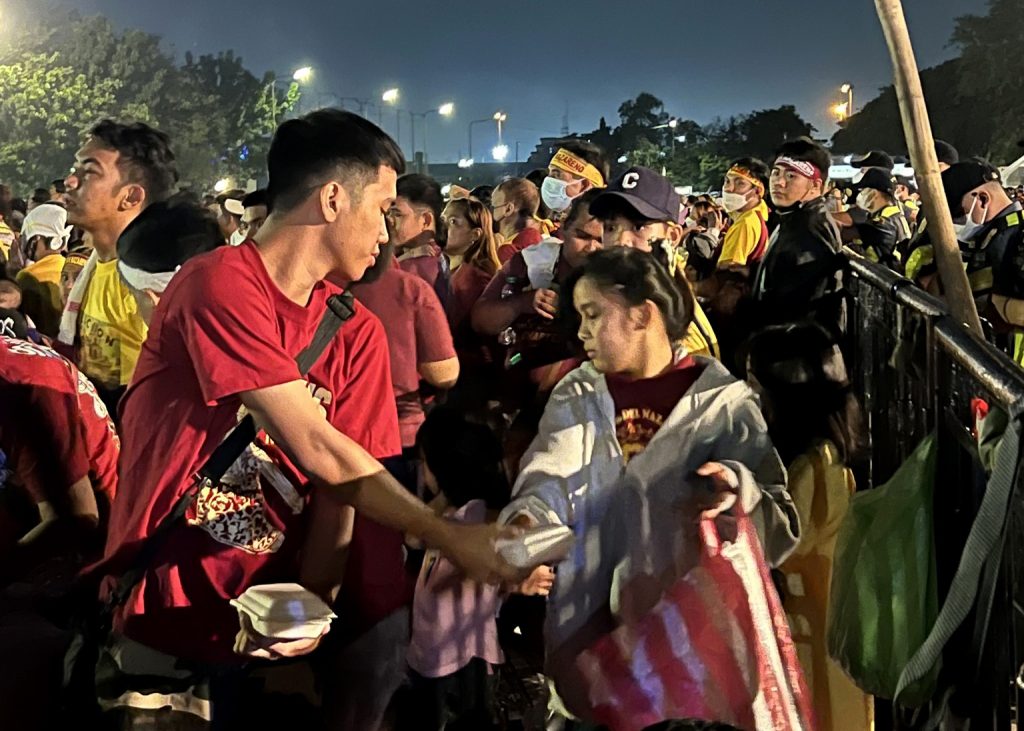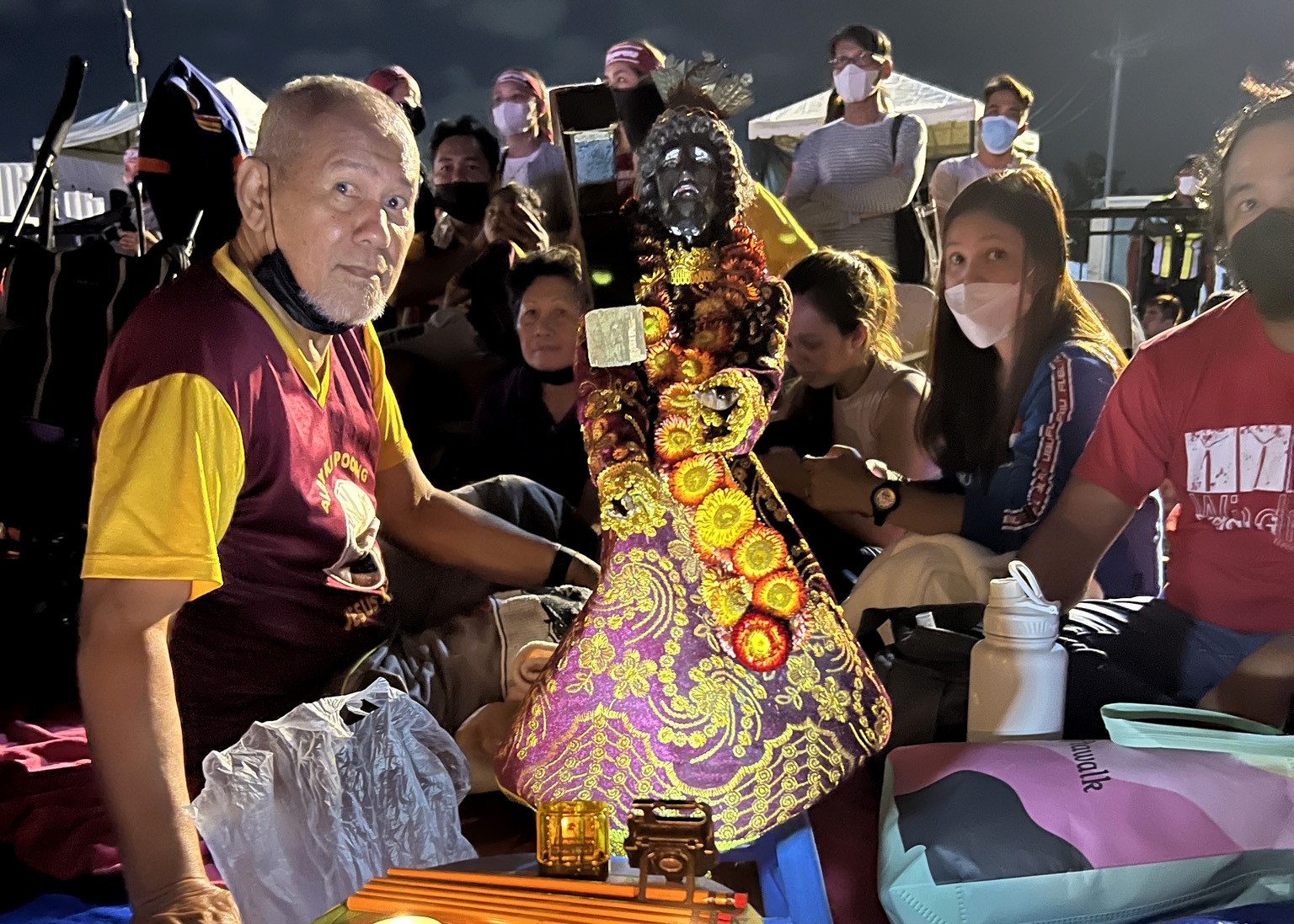I arrived maybe an hour before the Mass. I had to follow a long queue to the Luneta Grandstand. There were actually two long lines of people — one to touch the image (and that queue was longer); the other just to enter the area for the celebration of the Mass.
I followed the second and when I reached there, it is standing room only (well, SGO, “standing ground only”). There was no more space even to stand. People have occupied it since 6 p.m., according to the kind old man who invited me to stand next to him: “Pwede ka pa rito. Kasya tayong lahat dito (You can stay here. There’s enough space for all of us).”
Before the Mass, we chatted a bit. He is from Isabela but now resides in Taguig. I do not know what his work is. But he makes it a point to come to Luneta or Quiapo every January 9. I always thought that the devotees just come for the procession. And there is no “Traslacion” this year. But he said he could no longer do it. His frail body does not allow him. “Nandito lang ako para makadalo sa Misa. Mahalaga sa akin yon (I come here just to attend Mass. It is important for me).”
I noticed he was so fervent during the Mass. He could not sing all the songs; he does not even join all the responses. But he was recollected in prayer. He was intently listening to the homily and was later looking for the communion minister to receive communion.
When the final hymn was sung (Nuestro Padre Jesus Nazareno), he raised his white “panyo (handkerchief)” in last prayer to the Nazareno. That “labakara (towel)” is what workers use to wipe their sweat during the noonday heat. After that, we bid goodbye. I thanked him for receiving me. That was 2 a.m., January 9. Today, he may be back to his daily work.
There were other persons beside me. They all joined in the entrance song with hands raised as if in surrender to the Poong Nazareno. Everybody’s hands, with eyes closed and occasional shouts of praise.
There were several mothers carrying their small infants, at least every five meters apart. Remember, this is cold midnight in an open air! There were also old people; some in wheelchairs, others in crutches. There was a mother hugging her PWD son in his twenties. She was teaching him how to raise his hand in prayer and sing with everyone. You can only imagine what their prayer can be.
Outsiders will see their TV screens and say this as fanaticism or superstition. But on the ground, this is deep prayer of a people in need, of a silently suffering people.

We have survived rampant senseless extrajudicial killings for six years. And no justice is in sight. The perpetrators are all in power. We have survived COVID-19. And people are still grieving for the death of their loved ones, much more with the psychological effects of pandemic. Jobs are scarce, prices are rising not just the proverbial onion, and the government does not give us any hope. It takes only a little stretch of imagination what these people are actually praying for.
I realize that one has to be on the ground to listen to what people really pray for. To pray, we need to feel our bodies, people’s bodies, people’s suffering bodies or joyful bodies, celebrating bodies. Their prayer made me also look into myself and utter my deepest prayer from within my heart.
Right after communion, a group of people next to us, opened their baon, began distributing food packs, and started eating. It was still the communion rite (because the priest was still on the lectern thanking a long list of dignataries who helped him organize the event).
But for the people on the ground, it is time to share food together with “the body of Christ.” The food and water were not only for their group. It was for all who want it. I shared my food pack to the person next to me; I just took the water. Liturgists can debate without end about liturgical rules during the Mass. But is this not the real communion? A communion not only of wafer (the body of Christ as food for the “soul”?) but also of real food for tired and hungry bodies which were queueing for hours? A real communion of lives, of peoples, of bodies.

For spirituality can only be bodily. Our bodies are the only ways we have to God. This incarnational approach to the divine runs counter to the intellectualist Western tradition which privileges the inner mental state, the esoteric experience, the internal consciousness. The Platonic disdain for the material dismisses the bodily, the sensuous and the ordinary as quite base and lowly. Yet we can only think of God through these sensuous realities. It is thus imperative that all pastors and church ministers immerse themselves and get involved in the tempo of people’s practices.
Synodality is not only about listening to words and sharing our minds; it needs bodies!
Moreover, if the Church is to help mediate and channel God’s salvation into the human community, these practices should be considered as the way in which the Church must walk and think for it is here that people articulate the acts of God experienced in their everyday life.

For ordinary people, these everyday practices which are deeply intertwined with one’s cultural memories and religious histories are the only wells from which they can draw the strength needed in their daily struggle for survival.
But one further question for all: Can our praying bodies, moving bodies, dancing bodies place themselves on the line and stand up to protect the thousands of dying bodies around us? Can we speak out against the injustice and callousness of our leaders? Can our faith be bodily and political? The bodies which are dying are the same body of Jesus which we receive in communion, and the Jesus on the altar to which we wave in supplication.
Or, shall we keep waving handkerchiefs and dancing in front of our santos while we leave the many others to continue to die on our streets, in their shanties or in the far-flung mountains where violence still continues without them being flashed on our screens?
Father Daniel Franklin Pilario, C.M., is a theologian, professor, and pastor of an urban poor community in the outskirts of the Philippine capital. He is also Vincentian Chair for Social Justice at St. John’s University in New York. The opinions and views expressed in this article are those of the authors. They do not purport to reflect the opinions or views of LiCAS News or its publishers.







